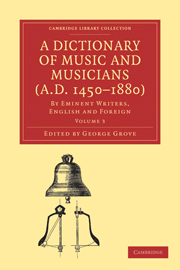Book contents
Summary
QUADRILLE (German Contretanz), a dance executed by an equal number of couples drawn up in a square. The name (which is derived from the Italian squadra) was originally not solely applied to dances, but was used to denote a small company or squadron of horsemen, from 3 to 15 in number, magnificently mounted and caparisoned to take part in a tournament or carrousel. The name was next given to 4, 6, 8, or 12 dancers, dressed alike, who danced in one or more companies in the elaborate French ballets of the 18th century. The introduction of ‘contredanses’ into the ballet, which first took place in the 5th act of Rousseau's ‘Fêtes de Polymnie’ (1745), and the consequent popularity of these dances, are the origin of the dance which, at first known as the ‘Quadrille de Contredanses’ was soon abbreviated into ‘quadrille.’ The quadrille was settled in its present shape at the beginning of the 19th century, and it has undergone but little change, save in the simplification of its steps. It was very popular in Paris during the Consulate and the first Empire, and after the fall of Napoleon was brought to England by Lady Jersey, who in 1815 danced it for the first time at Almack's with Lady Harriet Butler, Lady Susan Ryde, Miss Montgomery, Count St. Aldegonde, Mr. Montgomery, Mr. Montague, and Mr. Standish.
- Type
- Chapter
- Information
- A Dictionary of Music and Musicians (A.D. 1450–1880)By Eminent Writers, English and Foreign, pp. 55 - 62Publisher: Cambridge University PressPrint publication year: 2009First published in: 1883



